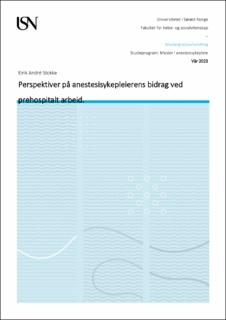| dc.contributor.advisor | Leonardsen, Ann-Chatrin Lindqvist | |
| dc.contributor.author | Stokke, Eirik Andre | |
| dc.date.accessioned | 2023-07-12T16:41:48Z | |
| dc.date.available | 2023-07-12T16:41:48Z | |
| dc.date.issued | 2023 | |
| dc.identifier | no.usn:wiseflow:6846425:54825599 | |
| dc.identifier.uri | https://hdl.handle.net/11250/3078370 | |
| dc.description.abstract | Introduksjon: Anestesisykepleieren er en bærekraftig og resurseffektiv del av helsevesenets pasienttilbud, som skal kunne benyttes ved prehospitalt arbeid, transportmedisin og ved katastrofer og beredskapssituasjoner. Anestesisykepleieren skal etter utdannelse være i stand til å selvstendig analysere, vurdere og ivareta vitale funksjoner hos akutt kritisk syke og skadde personer i og utenfor sykehus.
Hensikt: Hensikten med oppgaven har vært å belyse perspektiver på anestesisykepleierens bidrag ved prehospitalt arbeid.
Metode: Oppgaven baserte seg på en kvalitativ forskningsmetode, med et induktivt og eksplorerende design. Datamaterialet ble innhentet gjennom individuelle intervjuer med ambulansepersonell i prehospitale tjenester (n=1), og anestesisykepleiere fra to sykehus (n=3). Intervjuene ble ledsaget av en semi-strukturert intervjuguide. Intervjuene ble transkribert og analysert med en tematisk innholdsanalyse som resulterte i tre temaer: 1) Kompetanse og erfaring med overføringsverdi, 2) Ikke automatisk kvalifisert gjennom utdanning og 3) variasjoner i utnyttelse av anestesisykepleier ressursen.
Resultater: Resultatene antydet at anestesisykepleiere innehar et kunnskapsnivå, som med erfaring fra anestesiavdelingene vil kunne ha nytteverdi ved prehospitalt arbeid. Informantene mente at en ikke automatisk kvalifiserte til å jobbe prehospitalt basert på utdannelsen alene, men at det ville kreves tilleggs opplæring eller kurs innen enkelte emner. For benyttelse av anestesisykepleieren som en ressurs, pekte informantene på at det gjennom organisasjon og system burde gjøres vurderinger som var tilpasset lokale forhold. Videre viste de til at anestesisykepleiere i samarbeid med ambulansepersonell ville kunne utfylle hverandre og utgjøre en styrke i pasientbehandlingen.
Konklusjon: Anestesisykepleieren innehar relevant kunnskap, som gjennom erfaring fra anestesiavdeling vil kunne benyttes prehospitalt. Ved å gi anestesisykepleiere innføringer i temaer som er gjeldende for prehospitalt arbeid, vil anestesisykepleieren utgjøre en ressurs både som selvstendig fagperson og ved samhandling med annet prehospitalt helsepersonell. Selv om det nå finnes en bachelor i paramedisin, tyder resultater fra oppgaven og funn i litteratur på at, anestesisykepleiere fortsatt er en faggruppe som med kunnskaper og erfaringer vil kunne nyttiggjøres prehospitalt. | |
| dc.description.abstract | Introduction: Anaesthetic nurses is a resource-efficient and vital part of the patient’s healthcare service. Anaesthetic nurses are situated in prehospital services, transport medicine as well as disaster and emergency care. After education, the anaesthetic nurse should be able to independently analyse, assess and deliver lifesaving and advanced care targeting vital functions in acutely critically ill and injured persons in and outside hospitals.
Purpose: The aim of this master thesis is to illuminate the perspectives on anaesthetic nurse contribution in prehospital care.
Method: The master thesis was based on a qualitative research method, with an inductive and exploratory design. The data was obtained through individual interviews with one emergency medical personnel in pre-hospital services and anaesthetic nurses from two hospitals (n=3). The interviews were accompanied by a semi-structured interview guide. The interviews were transcribed and analyzed with a thematic analysis which resulted in three themes: 1) Competence and experience with transfer value, 2) Not automatically qualified through education and 3) variations in utilization of the anaesthetic nurse resource.
Findings: The result of the thesis implies that the anaesthetic nurse possesses a level of knowledge – with experience from departments of anaesthesiology, that is useful in prehospital care units. The informants weren’t in the belief that they will automatically qualify for jobs in prehospital care units, based on education itself, but that additional training or courses in certain subjects would be required. In order to use the anaesthetic nurse as a resource, the informants pointed out that assessments should be made through organization and systems that were adapted to local and conditions. They also outpointed that the anaesthetic nurse together with emergency medical personnel complement each other and therefore would be able to increase the patient care outside hospital.
Conclusion: Nurse anaesthetist do have relevant knowledge, through their work in the department of anaesthesiology, to become a recourse in prehospital care units. By giving them introductions in areas which is appliable for prehospital care, they will constitute as a resource both independently and in interaction with other prehospital healthcare workers. Although that the bachelor in paramedics do exist, results of this thesis and literature suggest that anaesthetic nurses is a group of professions that with their knowledge and experiences will benefit the prehospital care units and the treatment to patients outside of hospital. | |
| dc.language | nob | |
| dc.publisher | University of South-Eastern Norway | |
| dc.title | Perspektiver på anestesisykepleierens bidrag ved prehospitalt arbeid | |
| dc.type | Master thesis | |
